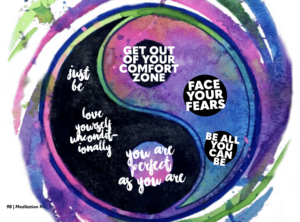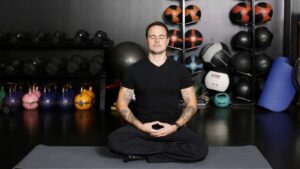
Many of us don’t realize that back pain and posture are usually interrelated. However, it can be very difficult to improve one’s posture to fix this pain. You might be surprised to learn that meditation can help with this. Below you’ll discover more about how to improve posture and five ways meditation can assist you.
What Causes Back Pain?
Back pain is caused by a variety of different issues. Some of the most common reasons are:
- Incorrect posture
- Muscle strain
- Herniated disc
- Sciatica
- Improper lifting techniques
- Degenerative disc diseases
Common Back Pain Symptoms
This problem not only causes uncomfortable shooting pain up and down your spine, but can result in many other unpleasant symptoms as well.
- Burning sensations around your back
- A tingling feeling in your legs
- Stiffness that makes it hard for you to move
- Swelling
- Numbness
Is Using Correct Posture Really That Important?
Most of the time back pain is the result of nothing more than poor posture. By using correct posture, it will ensure your spine stays aligned. This prevents vertebrae from slipping out of place which could result in nerve pain. It also stops spinal fatigue which can weaken the bones in and around your spine. Besides this, you’ll also find that correct posture can increase your energy and avert tension.
5 Tips to Improve Posture and Stop Back Pain With Meditation

https://www.pexels.com/photo/woman-doing-yoga-inside-a-room-3094215/
Use Deep Breathing
Deep breathing has been shown to calm tension and stress. This can reduce tightness in your back because it tricks your brain’s pain receptors.
To do deep breathing, first find a comfortable place to sit. Close your eyes and take a deep breath through your nose. Hold this for a few seconds and then slowly exhale through your nose. Repeat this motion a few times. You should start to feel your body relax. If necessary, you can put your hand on your stomach to feel your body inhaling and exhaling which can help your mind focus on the exercise.
Practice Simple Yoga Poses When Meditating
Another way to improve your posture and stop back pain is to incorporate yoga into your meditation sessions.
Mountain Pose
This pose stretches your back muscles to release tension and keep your spine aligned. To begin, stand as straight as you can while keeping the sides of your toes together. Use your feet to lift your body slightly up and to move from side-to-side.
Once you do this, tighten your thighs and slowly lift your knees as high as they can go. As you do so, turn them inward. Repeat with your other leg.
Cat-Cow Stretch
The cat-cow stretch helps to strengthen your neck and spinal muscles. The first step is to get down on all fours. Make sure to keep your palms flat on the ground. Take a deep breath and arch your back while leaning your head toward the ground. Hold this position for a few seconds and return to the original pose. Then, curve your stomach down to the ground while lifting your head up. Hold for a few more seconds and then return the original pose. Continue this stretch about 10 more times.
Downward Facing Dog
Downward facing dog stretches all the muscles in your back as well as your arms and legs. The first step is to stand straight and then lower your palms to the ground. Your body should make a v-shape. Once you reach this position, lift your lower back up and hold. Release and then tighten your shoulder blades. Hold for a few seconds and then release.
Sphinx Pose
This pose has been shown to help reduce back pain by relaxing your back muscles. To do this, lie on your stomach on the ground. Keep your arms flat by your sides. Then, tighten your legs and lift your chest off the ground. You can use your arms to assist with this. Make sure to keep your legs on the floor. Hold the pose for about 10 seconds and then return to the original position.
Sit in a Comfortable Position
It’s important that you sit in a comfortable position when meditating. Most of the time, people will either sit with their legs crossed on the ground or in a chair. By doing so, it provides support to your lower back and prevents strain.
As you sit, make sure your head and neck are aligned with your spine. Otherwise, your body might lean more toward one side which can create pressure on certain joints and muscles.
To help with this, it might be good to use a lumbar cushion. This cushion is comfortable to sit on and can help keep proper back alignment.
Focus Your Mind on Other Things
It can be difficult to focus your mind on other things when you’re in pain. However, meditation teaches you how to do so. When meditating, you’ll find that your brain relaxes. This can instantly calm stress and anxiety. It will also help you to concentrate on other things rather than the pain you might be suffering from.
When meditating, close your eyes and take a deep breath. Focus on a positive word and repeat this in your mind for a few minutes. You’ll soon find that your mind isn’t dwelling on your pain, but on this word instead.
Another way to focus your mind on something else during meditation is by using visualization techniques. For this, instead of thinking of a positive word, imagine a peaceful setting. You can then think about being in this peaceful setting without back pain. Over time, this can reduce tension and help you to be more positive toward making a change in your posture.
Write Down Your Thoughts
This might sound a bit strange, but writing can actually help reduce back pain. If you have tension or are thinking about your back pain, it can major discomfort in your body. When meditating, scribbling down your thoughts or drawing out how you feel can help release some of this tension. This can reduce back pain which can encourage you to use proper posture.
Meditation not only reduces stress but can improve posture and decrease back pain. Because of this, it might be ideal to consider trying for natural pain relief.
References















The symbiotic relationship between meditation and physical health, as detailed by Dr. Brent Wells, elucidates the deep-rooted connections between mind, body, and well-being. This insightful article unfolds the often-overlooked advantages of meditation in addressing back pain and improving posture, demystifying the potent power of mindfulness in holistic health. The recommended yoga poses not only provide therapeutic relief but, when coupled with the right alignment techniques, can pave the way for lasting well-being. This holistic approach aligns perfectly with the essence of patient education and rehabilitation methods discussed in “Comparing Chiropractic and Physiotherapy Protocols with a Focus on Patient Education for Empowered Rehabilitation“. Merging meditation’s tranquility with the structured guidance of rehabilitation practices offers a comprehensive pathway to sustained health and wellness.